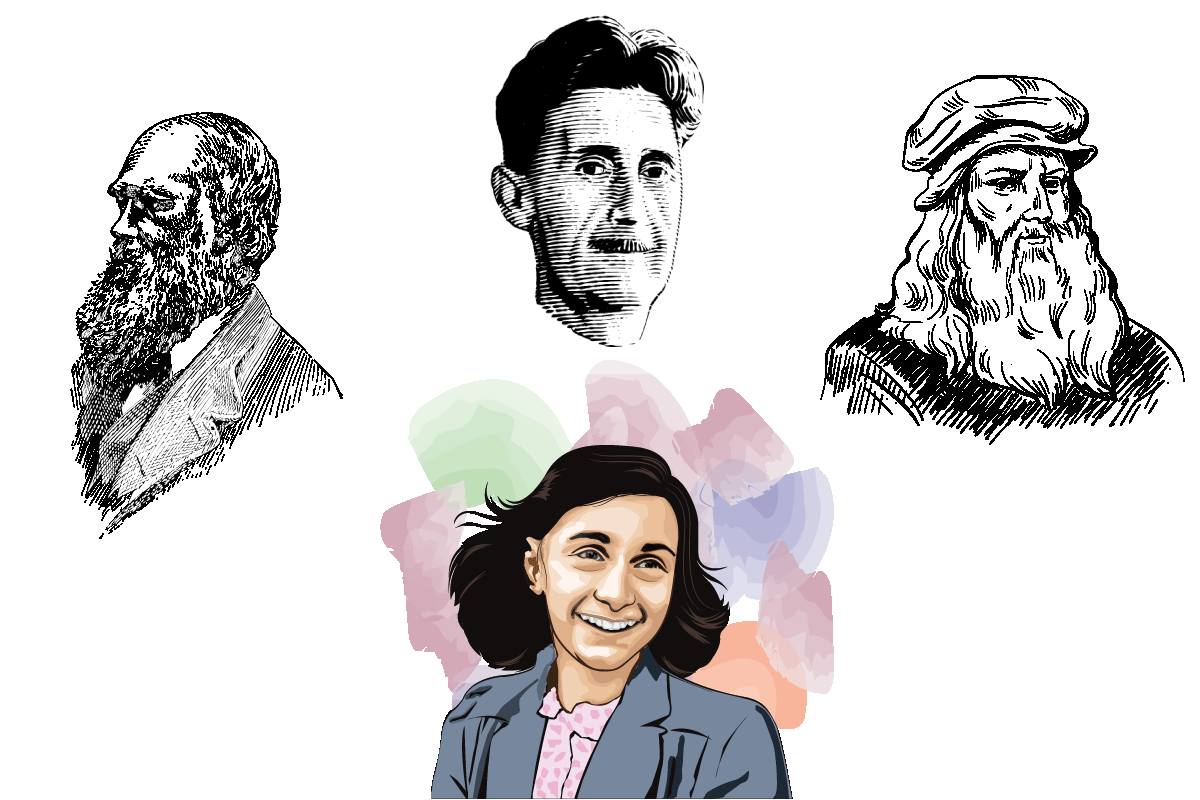Fascinating Diary Entry Examples from 4 Iconic Diarists
Explore the intimate worlds of Leonardo da Vinci, Charles Darwin, George Orwell, and Anne Frank through their profound diary entries, revealing thoughts that shaped history and inspired generations. Their timeless entries will motivate you to begin your own diary journey.

Diaries have long served as an intimate window into historical moments, shaping our understanding of the people who’ve penned them. Whether illuminating the depths of individual creativity, marveling at the nuances of evolutionary theory, exploring societal shifts, or bearing witness to the harrowing experiences of war, diaries offer a unique perspective on history. Here, we explore some notable diary entries from four famous diarists: Leonardo da Vinci, Charles Darwin, George Orwell, and Anne Frank.
1. Leonardo da Vinci (1452-1519)
Though primarily revered as a Renaissance artist and scientist, Leonardo da Vinci also maintained journals that contain a blend of his scientific diagrams, musings, and personal anecdotes. His diary entries are often a clear demonstration of a mind at work, leapfrogging from mechanical inventions to studies of nature and human anatomy.
Excerpt from Leonardo’s Journals
Human Anatomy
“The human foot is a masterpiece of engineering and a work of art.”

Leonardo marvels at the complexity of human anatomy, reflecting his deep interest in and study of the human body which often intersected with his art, allowing him to create extraordinarily precise and lifelike depictions in his sculptures and paintings.
Natural Phenomena
“Water is the driving force of all nature.”
This diary entry highlights Leonardo's observations and philosophies regarding natural elements. His study of water flows, in particular, spurred him to design various devices, including schemes for diverting rivers, along with the theoretical underpinnings of what would become fluid dynamics.
Aerial Machines
“Once you have tasted flight, you will forever walk the earth with your eyes turned skyward, for there you have been, and there you will always long to return.”

Long before the Wright brothers, Leonardo was sketching designs for flying machines, driven by his belief that humans could one day soar like birds. His notes feature rudimentary helicopter designs, parachutes, and ornithopter prototypes, showcasing his forward-thinking and innovative spirit.
Art and Science
“Principles for the Development of a Complete Mind: Study the science of art. Study the art of science. Develop your senses — especially learn how to see. Realize that everything connects to everything else.”
Leonardo did not draw hard lines between disciplines. His approach was holistic, finding connections between art and science that enriched both fields. This entry encapsulates his interdisciplinary method, encouraging a synergy between sensory experience, artistic creativity, and scientific inquiry.
2. Charles Darwin (1809-1881)
Charles Darwin’s diaries provide crucial insights into his scientific thought process and discoveries. His most famous voyage aboard the HMS Beagle revealed observations that would later form the basis of his theory of evolution by natural selection.
Photo by Hulki Okan Tabak / Unsplash
Excerpt from Darwin's Beagle Diary
January 1832 - Tierra del Fuego
“...the savages appeared miserable and degraded. They were absolutely naked, and the weather bitter cold, with heavy hailstorms...”
This entry from Tierra del Fuego not only details his anthropological interest but also reflects his initial encounters and reactions to different cultures and environments, which sometimes challenged his European sensibilities.
July 1833 - Mendoza, Argentina
“An earthquake most fortunately experienced by me — the phenomena very interesting—remarkable fact that oscillations were in direction NW by W & SE by E which, if from shock, would have come from N. by E.”
In this entry, Darwin describes experiencing an earthquake, providing a detailed account that represents a pivotal moment in forming his geological theories. His observations of the event's directionality played a role in his later understanding of Earth's structural movements.
September 1835 - The Galápagos Islands
“I never dreamed that islands, about fifty or sixty miles apart, and most of them in sight of each other, formed of precisely the same rocks, placed under a quite similar climate, rising to nearly equal heights, would have been differently tenanted.”
Perhaps one of the most iconic moments of the Beagle expedition, his time in Galápagos led to significant revelations about species variation -- observations that would eventually lead to the development of his theory of natural selection.
January 1836 - Sydney, Australia
“Australia is rising into importance. The whole country is in a ferment from the gold discovery. I feel by conviction that New South Wales will before many years become splendid country.”
Here, Darwin reflects on the socioeconomic changes in Australia, provoked by the gold rushes. These entries are valuable for understanding Darwin's perceptions of economic development and its environmental impacts.
October 1836 - Return to England
“The sight of the British coast was glorious for me; I never expected such intense happiness in rejoining my family. My mind will long be occupied with vivid recollections of past scenes.”
Upon concluding his voyage, Darwin expresses his profound personal joy upon returning home. This entry marks a reflective pause, juxtaposing his scientific pursuits with fond personal emotions, a reminder of the human element in scientific exploration.
3. George Orwell (1903-1950)
Known for his sharp critiques of totalitarian regimes and social injustices, George Orwell’s diaries touch on everything from everyday life in mid-20th-century Britain to his experiences during the Spanish Civil War.

Excerpt from Orwell's Diary during the Spanish Civil War
19th July 1936 - Spanish Civil War
“Marvellous atmosphere. Complete irresponsibility. Looting of small shops going on everywhere and no police force visible.”
Here, Orwell begins documenting his observations during the Spanish Civil War, remarking on the chaos and lack of authority control, which deeply influenced his political writings, reflected later in works like "Homage to Catalonia."
26th October 1940 - London, World War II
“The air-raid sirens are growing into a ‘normal’ part of life. Saw the wreckage of several houses on my way to the grocery. It’s strange how quickly human adaptability comes to play.”
This entry illustrates the grim reality of life during the Blitz in London, offering a firsthand account of the impact of regular bombings on the daily lives and psyches of British citizens.
3rd January 1941 - Reflection on British Society
“At present, there is a feeling of helpless despair, but no positive anger. The people are discontented, but there's no platform for revolt.”
Orwell’s entry reflects his perception of British society during WWII, capturing the mood of resignation and the absence of a clear path for action among the populace, themes that resonate in his later dystopian visions in "1984."
15th August 1942 - Orwell’s Farm
“Large, rainless days. Harvest going on. The anticipatory silence of the country impresses me as being one of the minor evils of war.”
Outside of his political reflections, Orwell’s diaries are also rich with pastoral imagery and rural life moments, providing a stark contrast to his more intense wartime entries and mirroring the idyllic descriptions found in "Animal Farm."
Photo by Shraddha Agrawal / Unsplash
9th October 1945 - Post-War Reflection
“Everyone speaks of peace, but the war against deprivation and despair is just as challenging and constant.”
After the conclusion of World War II, Orwell’s writings continued to focus on social challenges, reflecting his career-long concern with injustice and power misuse. This entry employs his typical critical lens, examining the socio-economic struggles that persisted even in peacetime.
4. Anne Frank (1929-1945)
Perhaps one of the most poignant diarists, Anne Frank wrote her diary while hiding from the Nazis during World War II. Her diary entries reveal the hopes, fears, and mature reflections of a young girl amid one of history’s darkest hours.
Photo by Kelly Sikkema / Unsplash
Excerpt from Anne Frank’s Diary
12th June 1942
“I hope I will be able to confide everything to you, as I have never been able to confide in anyone, and I hope you will be a great source of comfort and support.”
On her thirteenth birthday, Anne received this diary as a gift and initiated her entries with hopes of finding a confidante in its pages. This first entry sets a tone of intimacy and hope that characterizes many of her subsequent writings.
8th July 1942
“...then the news came that we had to go into hiding. Not in the countryside but in the city itself... The 'Secret Annex' as we call it is in an old office building...”
A mix of confusion and fear is evident as Anne describes the sudden shift to life in hiding. Even in these unsettling first impressions, her detailed observance provides a clear sense of the environment they were forced to adopt as a temporary home.
20th June 1942
“As long as this exists,” I thought, “this sunshine and this cloudless sky, and as long as I can enjoy it, how can I be sad?”
Despite the harsh conditions, Anne frequently found solace in nature’s beauty visible from her limited view. This entry reflects her ability to seek joy and comfort in small, everyday wonders—a recurring theme throughout her writings.
3rd May 1944
“I want to go on living even after my death! And therefore I am grateful to God for giving me this gift... of expressing all that is in me.”
This poignant reflection illustrates Anne's deep desire to make a lasting impact, voicing a wish that poetically came true as her diary went on to touch millions around the world.
15th July 1944
“It’s a wonder I haven’t abandoned all my ideals, they seem so absurd and impractical. Yet I cling to them because I still believe, in spite of everything, that people are truly good at heart.”
Perhaps one of her most famous diary entries, this excerpt underscores Anne’s enduring optimism and faith in humanity even in the face of overwhelming adversity. It captures a core aspect of her moral clarity and hope, which continues to inspire people globally.
Anne’s ability to maintain hope and positivity in such dire circumstances continues to inspire millions around the world. Her diary provides a deeply personal account of the Holocaust, serving as a powerful reminder of the human consequences of hatred and persecution.
Leonardo's innovations, Darwin's discoveries, Orwell's criticisms, and Anne's resilience under oppression; together, these diaries meld into a fascinating historical tapestry. Through their entries, we gain not only historical insights but also timeless lessons in perseverance, curiosity, critical thinking, and hope. Taking a leaf from their journals, we find that despite varying circumstances, the human spirit consistently strives towards understanding, betterment, and survival.
As we examine the captivating diary entries examples of the 4 iconic diarists, we are reminded of the power and endurance of personal reflection. Emulate these iconic diarists by using the Journey to preserve your own thoughts and experiences. Start your lifelong habit of diary-writing today and keep your memories alive forever.





